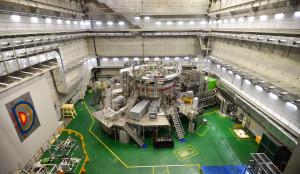Fusion world
Record results at KSTAR
18 Sep 2017
-
Alberto Loarte, Confinement & Modelling Section Leader
Through long-pulse operation, the Korean tokamak KSTAR is capable of contributing to the investigation of the plasma physics of ITER, and future steady-state fusion power plants.
Experiments in the Korean tokamak KSTAR in 2017 achieved record-length periods of ELM suppression by the application of three-dimensional magnetic fields with internal coils, which is the same approach for ELM control in ITER.
Edge localized modes (ELMs), which can occur during high-performance operation mode (H-mode), expel bursts of energy and particles from the plasma. The energy released can cause erosion in surrounding material, with potential impact on the lifetime of plasma-facing materials.
The new KSTAR results demonstrate the robustness of the ELM control scheme adopted for ITER. They have also provided interesting information regarding the influence of the effects of the plasma shape on the robustness of this scheme for its practical application in ITER.
In addition, robust ELM suppression has been obtained in KSTAR with 3D magnetic fields with one and two symmetry periods in the toroidal direction (n = 1, 2) over a range of plasma currents and toroidal fields, whose ratios corresponds to the expected range for long-pulse operation in ITER (burns of 1,000 to 3,000 seconds). This indicates that there might be more flexibility regarding the shape of the 3D magnetic field that needs to be applied for ELM control in the ITER long-pulse scenarios than previously considered.


